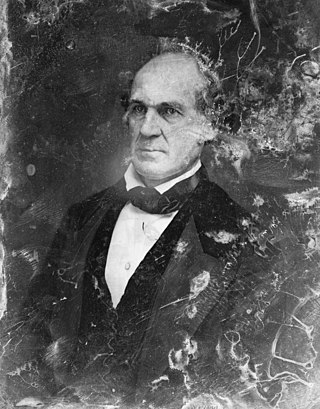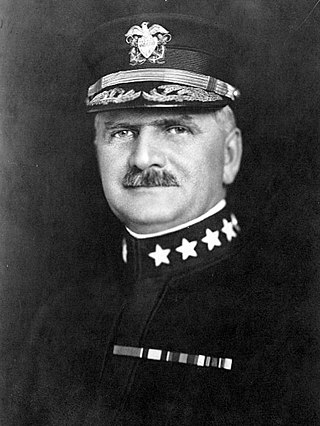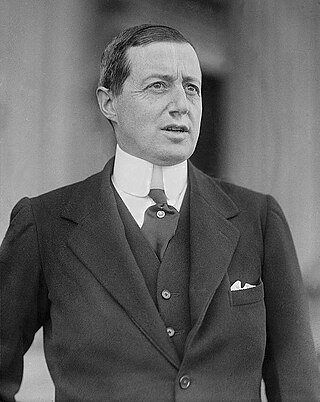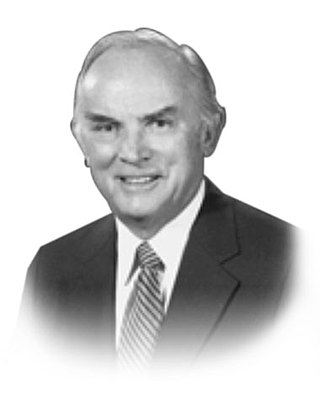
The Boston Navy Yard,originally called the Charlestown Navy Yard and later Boston Naval Shipyard,was one of the oldest shipbuilding facilities in the United States Navy. It was established in 1801 as part of the recent establishment of the new U.S. Department of the Navy in 1798. After 175 years of military service,it was decommissioned as a naval installation on 1 July 1974.

The history of the United States Navy divides into two major periods:the "Old Navy",a small but respected force of sailing ships that became notable for innovation in the use of ironclads during the American Civil War,and the "New Navy" the result of a modernization effort that began in the 1880s and made it the largest in the world by 1943.

Otto Hermann Kahn was a German-born American investment banker,collector,philanthropist,and patron of the arts. Kahn was a well-known figure,appearing on the cover of Time magazine and was sometimes referred to as the "King of New York". In business,he was best known as a partner at Kuhn,Loeb &Co. who reorganized and consolidated railroads. In his personal life,he was a great patron of the arts,where among things,he served as the chairman of the Metropolitan Opera.

George Edmund Badger was an American politician who served as a Whig U.S. senator from the state of North Carolina.

Robert Bacon was an American statesman and diplomat. He was also a leading banker and businessman who worked closely with Secretary of State Elihu Root,1905-1909,and served as United States Secretary of State from January to March 1909. He served as ambassador to France 1909 to 1912. He was a leader in the Preparedness Movement setting up training programs for would-be Soldiers before the United States entered the First World War in April 1917. He was defeated narrowly as a candidate for the United States Senate in 1916. He was commissioned as a major in the United States Army in 1917,and played a major role as Chief of the American Military Mission at British General Headquarters.

The United States Shipping Board (USSB) was established as an emergency agency by the 1916 Shipping Act,on September 7,1916. The United States Shipping Board's task was to increase the number of US ships supporting the World War I efforts. The program ended on March 2,1934.

Benjamin Williams Crowninshield served as the United States Secretary of the Navy between 1815 and 1818,during the administrations of Presidents James Madison and James Monroe.

Truman Handy Newberry was an American businessman and political figure. He served as the Secretary of Navy between 1908 and 1909. He was a Republican U.S. Senator from Michigan between 1919 and 1922.

Robert Edward Coontz was an admiral in the United States Navy,who sailed with the Great White Fleet and served as the second Chief of Naval Operations.

Joseph Knefler Taussig was a vice admiral in the United States Navy. He served in the Spanish–American War,Philippine–American War,China Relief Expedition,Cuban Pacification,World War I,Second Nicaraguan Campaign,and World War II.

William Henry Vanderbilt III was an American politician who served as Governor of Rhode Island from 1939 to 1941,and a member of the wealthy and socially prominent Vanderbilt family.

Adolph Edward Borie was a United States merchant and politician who briefly served (1869) as Secretary of the Navy in the Ulysses S. Grant administration.

Admiral Samuel Shelburne Robison CB,USN was a United States Navy officer whose service extended from the 1890s through the early 1930s. He held several major commands during World War I,and from 1928 to 1931 served as Superintendent of the United States Naval Academy. In 1933,Admiral Robison also founded a Naval Preparatory Academy in Pine Beach,New Jersey called Admiral Farragut Academy.

Peter Goelet Gerry was an American lawyer and politician who served in the United States House of Representatives and later,as a U.S. Senator from Rhode Island. He is the only U.S. Senator in American history to lose re-election and later reclaim his Senate seat from the person who had defeated him.

The Emergency Fleet Corporation (EFC) was established by the United States Shipping Board,sometimes referred to as the War Shipping Board,on 16 April 1917 pursuant to the Shipping Act to acquire,maintain,and operate merchant ships to meet national defense,foreign and domestic commerce during World War I.

Edwin Taylor Pollock was a career officer in the United States Navy,serving in the Spanish–American War and in World War I. He was later promoted to the rank of captain.

Benjamin Franklin Tilley was a career officer in the United States Navy who served from the end of the American Civil War through the Spanish–American War. He is best remembered as the first acting governor of American Samoa as well as the territory's first naval governor.

USS General G. W. Goethals (ID-1443) was a United States Navy cargo ship and troop transport in commission in 1919.
The Delaware River Iron Ship Building and Engine Works,was a major late-19th-century American shipyard located on the Delaware River in Chester,Pennsylvania. It was founded by the industrialist John Roach and is often referred to by its parent company name of John Roach &Sons,or just known as the Roach shipyard. For the first fifteen years of its existence,the shipyard was by far the largest and most productive in the United States,building more tonnage of ships than its next two major competitors combined,in addition to being the U.S. Navy's largest contractor. The yard specialized in the production of large passenger freighters,but built every kind of vessel from warships to cargo ships,oil tankers,ferries,barges,tugs and yachts.

William Paul Thayer was an American test pilot,flying ace,aviation executive,and United States Deputy Secretary of Defense during the Reagan Administration.


















